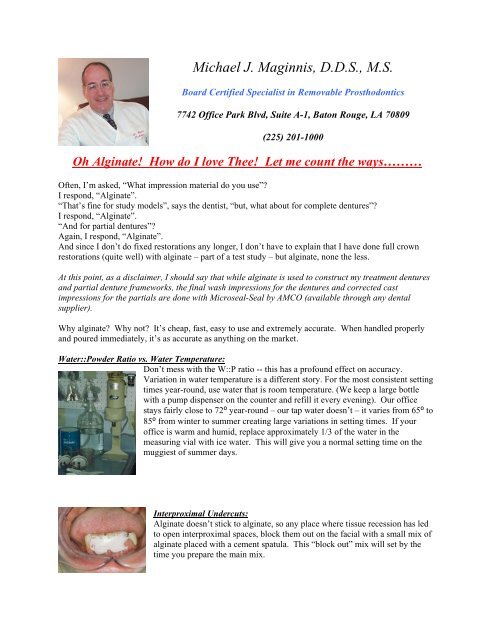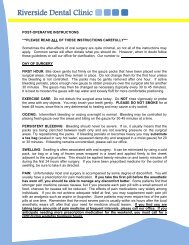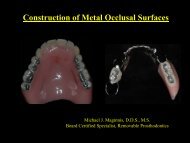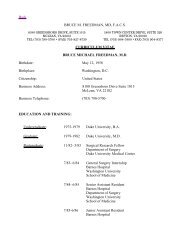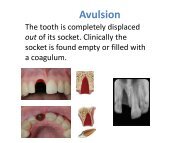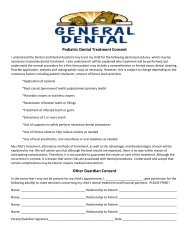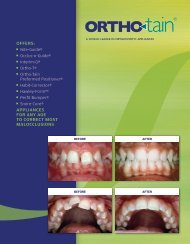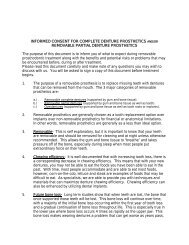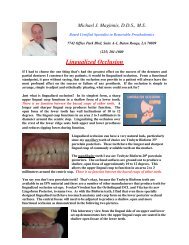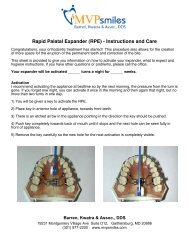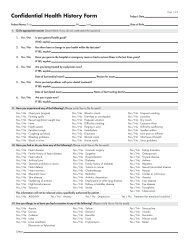Oh Alginate! How do I love Thee! Let me count the ways - ProSites
Oh Alginate! How do I love Thee! Let me count the ways - ProSites
Oh Alginate! How do I love Thee! Let me count the ways - ProSites
- No tags were found...
You also want an ePaper? Increase the reach of your titles
YUMPU automatically turns print PDFs into web optimized ePapers that Google loves.
Michael J. Maginnis, D.D.S., M.S.Board Certified Specialist in Removable Prostho<strong>do</strong>ntics7742 Office Park Blvd, Suite A-1, Baton Rouge, LA 70809(225) 201-1000<strong>Oh</strong> <strong>Alginate</strong>! <strong>How</strong> <strong>do</strong> I <strong>love</strong> <strong>Thee</strong>! <strong>Let</strong> <strong>me</strong> <strong>count</strong> <strong>the</strong> <strong>ways</strong>………Often, I’m asked, “What impression material <strong>do</strong> you use”?I respond, “<strong>Alginate</strong>”.“That’s fine for study models”, says <strong>the</strong> dentist, “but, what about for complete dentures”?I respond, “<strong>Alginate</strong>”.“And for partial dentures”?Again, I respond, “<strong>Alginate</strong>”.And since I <strong>do</strong>n’t <strong>do</strong> fixed restorations any longer, I <strong>do</strong>n’t have to explain that I have <strong>do</strong>ne full crownrestorations (quite well) with alginate – part of a test study – but alginate, none <strong>the</strong> less.At this point, as a disclai<strong>me</strong>r, I should say that while alginate is used to construct my treat<strong>me</strong>nt denturesand partial denture fra<strong>me</strong>works, <strong>the</strong> final wash impressions for <strong>the</strong> dentures and corrected castimpressions for <strong>the</strong> partials are <strong>do</strong>ne with Microseal-Seal by AMCO (available through any dentalsupplier).Why alginate? Why not? It’s cheap, fast, easy to use and extre<strong>me</strong>ly accurate. When handled properlyand poured im<strong>me</strong>diately, it’s as accurate as anything on <strong>the</strong> market.Water::Powder Ratio vs. Water Temperature:Don’t <strong>me</strong>ss with <strong>the</strong> W::P ratio -- this has a profound effect on accuracy.Variation in water temperature is a different story. For <strong>the</strong> most consistent settingti<strong>me</strong>s year-round, use water that is room temperature. (We keep a large bottlewith a pump dispenser on <strong>the</strong> <strong>count</strong>er and refill it every evening). Our officestays fairly close to 72⁰ year-round – our tap water <strong>do</strong>esn’t – it varies from 65⁰ to85⁰ from winter to sum<strong>me</strong>r creating large variations in setting ti<strong>me</strong>s. If youroffice is warm and humid, replace approximately 1/3 of <strong>the</strong> water in <strong>the</strong><strong>me</strong>asuring vial with ice water. This will give you a normal setting ti<strong>me</strong> on <strong>the</strong>muggiest of sum<strong>me</strong>r days.Interproximal Undercuts:<strong>Alginate</strong> <strong>do</strong>esn’t stick to alginate, so any place where tissue recession has ledto open interproximal spaces, block <strong>the</strong>m out on <strong>the</strong> facial with a small mix ofalginate placed with a ce<strong>me</strong>nt spatula. This “block out” mix will set by <strong>the</strong>ti<strong>me</strong> you prepare <strong>the</strong> main mix.
This may produce an unsightly facial surface on <strong>the</strong> model, but a very accurate lingual surface – after all,this is <strong>the</strong> portion of <strong>the</strong> model that <strong>the</strong> partial fra<strong>me</strong>work or bite splint has to fit.Mechanical vs. Hand-Spatulation:For <strong>the</strong> best results, use a <strong>me</strong>chanical spatulator with vacuum – mine islocated just outside <strong>the</strong> operatories as pictured above in <strong>the</strong> first figure.Short of this, I would recom<strong>me</strong>nd a Cadco Alginator or similar <strong>me</strong>chanicalspatulator. It can be used chairside and produces a consistently smoothmix that is relatively bubble-free.Custom Tray vs. Stock Tray:Yes, I have made very nice impressions with custom acrylic trays that have been perforated and paintedwith alginate adhesive – usually in a situation where <strong>the</strong> patient has a very limited oral opening.O<strong>the</strong>rwise, I use perforated stock trays that have been altered with periphery wax (coated with trayadhesive) to make sure <strong>the</strong> alginate is carried out to <strong>the</strong> borders of <strong>the</strong>vestibules and <strong>do</strong>wn to <strong>the</strong> depth of <strong>the</strong> mylohyoid space and over <strong>the</strong>retromolar pads. The patient’s existing pros<strong>the</strong>sis canbe used to judge <strong>the</strong> amount of wax needed. The waxis also used to reduce <strong>the</strong> thickness of alginate in <strong>the</strong>palatal vault – alginate works best at no greaterthickness than 6mm (1/4”). Beyond this, it slumps,producing a denture with little palatal seal and a partial fra<strong>me</strong>work that standsaway from <strong>the</strong> tissue.A 12cc disposable syringe can be used to inject a portion of <strong>the</strong>alginate into <strong>the</strong> vestibules and <strong>do</strong>wninto <strong>the</strong> mylohyoid space.A finger full of alginate is wiped across <strong>the</strong> palatalvault and onto <strong>the</strong> occlusal surfaces of any teeth thatare present. The loaded tray is seated from <strong>the</strong> rear to<strong>the</strong> front of <strong>the</strong> mouth. The lips are lifted up and over <strong>the</strong> borders of <strong>the</strong> tray whichis <strong>the</strong>n held in position. The impression is set one minute after <strong>the</strong> alginate nolonger sticks to your g<strong>love</strong>.Pouring <strong>the</strong>Impression:
Im<strong>me</strong>diately, if not sooner, is my best advice. Upon removing <strong>the</strong> impression from <strong>the</strong> mouth, rinse withtap water, spray with algicide, wrap in a wet paper towel and let sit 5 minutes while preparing stone orplaster for mixing. Just prior to pouring, rinse again in tap water, blow dry, spray with debubblizer andpour model.W ith apologies to Elizabeth Barrett Browning,Maginnis <strong>the</strong> Dentist


